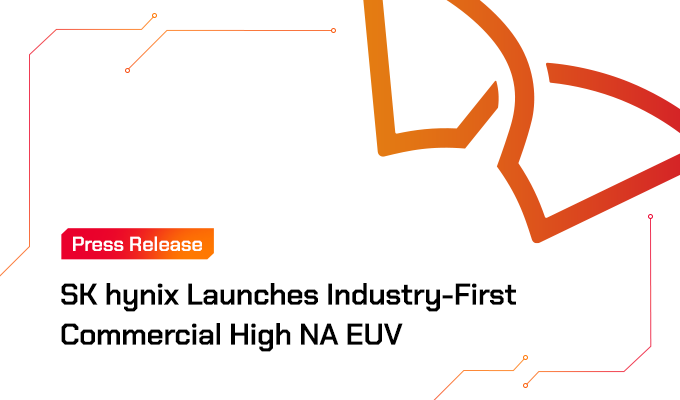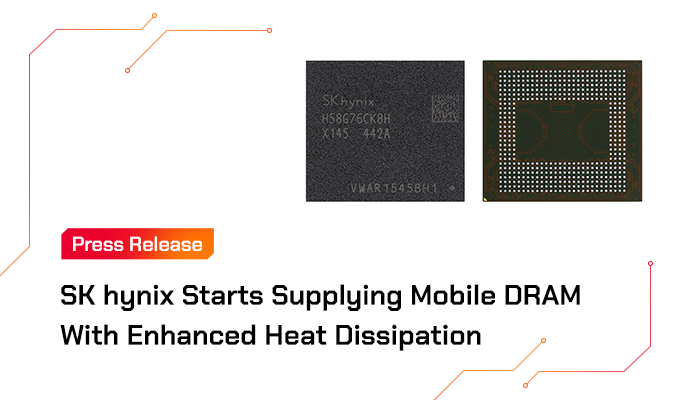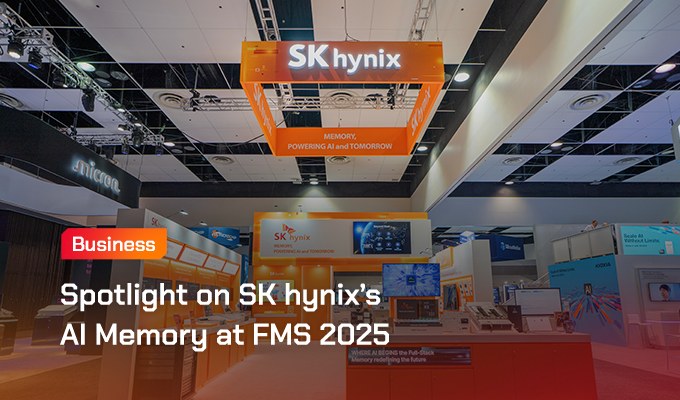- SK hynix and Intel co-published performance verification white paper on DDR5’s application to Intel CPUs for use in servers
- SK hynix’s DDR5 boosts server bandwidth by 70% while lowering power consumption by 14.4% compared to the product’s previous generation
- SK hynix plans to accelerate improvement in its second-half performance with its quality-certified DDR5
SK hynix announced on September 14th that it has co-published a white paper with Intel which reveals that its DDR5 server DRAM applied to Intel’s CPUs demonstrated industry-leading performance levels. This white paper was released simultaneously on the SK hynix and Intel websites.
The two companies have worked closely together since the beginning of DDR5’s development, and this white paper shows the results of performance evaluations of SK hynix’s DDR5 when applied to 4th Gen Intel® Xeon® Scalable processors1 (hereinafter referred to as Xeon) that took place over the past eight months.
Released at a time when the server industry has called for low-power, high-performance semiconductors, the white paper highlights that SK hynix and Intel will usher in an era of more advanced data centers through memory and CPUs that deliver industry-leading performance and energy efficiency.

The white paper reveals that SK hynix’s DDR5 uses 14.4% less power than DDR4, while the 4th Gen Intel® Xeon® Scalable processors offer performance efficiency that is 2.9 times greater than the previous generation2. In servers with Xeon, DDR5 achieved an improved performance per watt3 that was 1.22 times higher for integer computations and 1.11 times higher for floating point4 computations compared to DDR4.
Accordingly, the two companies expect the energy efficiency provided by DDR5 and Xeon to allow server chip customers to build more sustainable data centers. The operation of such cost-effective data centers is also expected to help customers save on the total cost of ownership (TCO)5.

“As revealed in the white paper, servers equipped with SK hynix’s DDR5 and Intel’s CPUs enable faster data processing speeds while consuming less power compared to the products’ previous generations. In particular, they can efficiently utilize high-density DRAMs required for processing vast amounts of data in applications such as generative AI,” said Sungsoo Ryu, head of DRAM Product Planning at SK hynix.
“We hope that our server chip customers will use the valuable information included in this white paper to drive their business forward,” he added.
Dr. Dimitrios Ziakas, Intel’s vice president of Memory and IO Technologies, said: “Intel has been collaborating with SK hynix and memory industry partners to enable high-performance DDR5 DRAM with 4th Gen Intel® Xeon® Scalable processors. These efforts ensure that we provide robust high-performance and energy-efficient data center system solutions to benefit our mutual customers.”
SK hynix will strengthen its offerings in the server market through collaborations, such as this latest project with Intel. By focusing on 1anm and 1bnm DDR5, the fourth and fifth generation of the 10nm process technology, respectively, SK hynix looks to increase its financial performance and presence in the server market as demand for server DRAMs is expected to rise in the second half of 2023.
[At a Glance] The Intel and SK hynix DDR5 Ecosystem White Paper (Read the full white paper)
- Bandwidth 70%↑6, Power Consumption 14.4%↓7, Integer Computations 1.59 times↑
The white paper details test data that server customers can use to guide their application of DDR5 in their servers. Highlights include the speed, performance, and power consumption that is attainable when combining DDR5 memory and Xeon.

Figure 1. Comparing the Server Bandwidth of SK hynix’s DDR4 and DDR5
Firstly, server bandwidth8 at the same operating speeds of 3,200 megabits per second (Mbps) increased by 20% with DDR5 compared with the previous generation, DDR4. Additionally, the server bandwidth at DDR5’s operating speed of 4,800 Mbps was 70% greater than it was at DDR4’s highest operating speed of 3,200 Mbps9. The overall expansion in the server bandwidth is due to the DDR5’s design improvements that minimized internal transfer latency of data and the securing of higher transfer speeds compared to DDR4.

Figure 2. Comparing Operating Speed and Power Consumption of SK hynix’s DDR4 and DDR5
Through the study, SK hynix was also able to confirm that DDR5’s power consumption was 14.4% less than DDR4 due in large part to new technologies such as High-K Metal Gate (HKMG). HKMG is a next-generation process that uses a High-K insulating film inside a DRAM transistor to prevent leakage current and improve its capacitance—the ability to store charge. Semiconductor memory products with HKMG therefore have a higher power efficiency.
Xeon’s built-in accelerators have also shown positive results in tests. Organizations can improve the average performance per watt efficiency for target workloads by up to 2.9 times utilizing the built-in accelerators compared to the previous generation of processors. The combination of these technologies enabled DDR5 and Xeon to achieve an excellent 50% increase in bandwidth and a 14.4% reduction in power usage.
The white paper also shows the computational performance of a system that combines DDR5 and Xeon. The companies used SPEC CPU 2017, a specialized benchmarking program, to compare performances.
Results from the comparison showed that integer computations were 1.59 times faster and floating point computations 1.43 times faster than the previous generation’s system. The performance per watt also saw its efficiency rise 1.22 times for integer computations and 1.11 times for floating point computations compared to the system’s predecessor.
The advanced system also performed well in the Intel Memory Latency Checker (MLC) test, a program that measures memory latency and speed. Compared to the previous generation, the read speed increased by 1.4 times and the read/write speed rose by 1.51 times.
Intel, the Intel logo, and other Intel marks are trademarks of Intel Corporation or its subsidiaries.
14th Gen Intel® Xeon® Scalable processors: These processors are Intel’s next generation of server CPUs that support PCIe Gen5 and next-generation DDR5 DRAM.
22.9x average performance per watt efficiency improvement for targeted workloads utilizing built-in accelerators compared to the previous generation.
New Configuration: 1-node, 2x pre-production 4th Gen Intel® Xeon® Scalable Processor (60 cores) with integrated Intel In-Memory Analytics Accelerator (Intel IAA), on pre-production Intel platform and software, HT On, Turbo On, Total Memory 1024GB (16x64GB DDR5 4800), microcode 0x2b0000a1, 1×3.84TB P5510 NVMe, Intel® Ethernet Controller X540-AT2, Ubuntu 22.04.1 LTS, 5.18.12-051812-generic, QPL v0.2.1,accel-config-v3.4.6.4, ZSTD v1.5.2, RocksDB v6.4.6 (db_bench), tested by Intel November 2022. Baseline: 1-node, 2x production 3rd Gen Intel® Xeon® Scalable Processors (40 cores) on SuperMicro SYS-220U-TNR, HT On, Turbo On, SNC Off, Total Memory 1024GB (16x64GB DDR4 3200), microcode 0xd000375, 1×3.84TB P5510 NVMe, Intel® Ethernet Controller X540-AT2, Ubuntu 22.04.1 LTS, 5.18.12-051812-generic, ZSTD v1.5.2, RocksDB v6.4.6 (db_bench), tested by Intel November 2022.
3Performance per watt: An indicator of how much computation is performed per watt of power consumed.
4Floating point: A concept about real numbers where integers and decimals are represented separately by changing the position of the decimal point to facilitate computation, as opposed to a fixed point where the decimal point is fixed in its original position. For example, if the original real number is 123.485, it can be written in floating points as 1.23485X 10^2, or 0.00123485X10^5.
5Total cost of ownership (TCO): The total costs of an asset that includes such as the initial investment, power, facility operations, and maintenance.
6Result obtained during simulations by SK hynix performed in December 2022.
7Power consumption comparison of DDR4 and DDR5 based on simulations by SK hynix’s power calculator.
8Server Bandwidth: The pathway through which data travels. An increase in bandwidth enables more data to be processed more efficiently at once.
9Bandwidth comparison based on increase from DDR4’s 3,200 Mbps operating speed to DDR5’s 3,200 Mbps and 4,800 Mbps speeds.








